Table of Contents
Every business seeks feedback from its customers to understand them better. This they do with the help of various surveys. Securing a good response rate is a challenge many times as customers do not complete the survey in full for various reasons. This may be due to disinterest in surveys or dislike of the product.
A business should know this aspect to improve, provide better services, and retain customers. For this, they should improve the response rate. This blog lets you understand how to better your survey response rates by changing your survey presentations.
What is a survey response rate?
A survey is likely successful based on the higher response it receives. A response rate is the percentage of people who participated in the survey compared to the percentage of people who viewed it. Not everyone who views or starts a survey completes it. This may be due to various reasons that should be corrected with effective strategies to make it a good response rate.
1. Shorter surveys: Reducing the survey from 37 questions in 2000 to 20-24 questions in 2001 minimized the number of mouse clicks and made completion easier.
2. Honest time estimation: The survey was modified to adhere to the promised 10-minute completion time genuinely.
3. Value proposition: The 2001 survey ensured participants derived value, offering them survey results, additional insights, and the allure of a contest.
4. Timing the survey: Invitations were most effective when sent mid-week post-noon, minimizing the chance of being overlooked or deleted.
5. Reminder strategy: A single reminder email significantly boosted responses by 15%.
6. Fax inefficiency: Fax invitations had a poor response rate of 1.8%, indicating their ineffectiveness for the target market.
7. Open-ended questions: Providing an avenue for participants to give descriptive responses, rather than just selecting "other," helped gain deeper insights.
These adaptations and insights were crucial in enhancing the survey's efficacy.
How is a survey response rate calculated?
The survey response rate is calculated by dividing the number of individuals who completed the survey by the number of individuals who were invited or targeted to take the survey. This result is then multiplied by 100 to express the value as a percentage.
Here's the formula for calculating the survey response rate:
__________________________________ X 100
Total no. of people to whom the survey was sent
For example, if you had sent the survey to 400 people and the responses received were 120, then the response rate would be (120/400) X 100 = 30%
A good response rate for surveys would be 40 to 50 percent. Organizations should plan the survey so that a good rate is achieved. Otherwise, it does not solve the purpose of the survey.
A good rate is not always achieved because organizations fail to follow certain effective strategies.
Strategies to achieve a good survey response rate
Improvement in survey response rates indicates better engagement with your customers. Follow these strategies to improve your response rates:
1. Keep it short
Do not make your surveys so long that it becomes a question-and-answer session. According to a survey, the response rates dropped by 5 to 20 percent when surveys took longer than 7 to 8 minutes. People abandon a survey mid-way when they find it time-consuming.
So always keep your surveys short and easily answerable by the customers. This will keep them engaged and let them complete the survey fully. Since surveys are important metrics for analyzing customer preferences and feedback, shortening the survey length needs consideration.
For example, in the survey below by Qualtrics, a data collection company, the survey is complete with just a click on the drop-down menu and checking on the circles. The survey is short and can be completed within seconds. Thus, the customer does not lose interest in the survey.
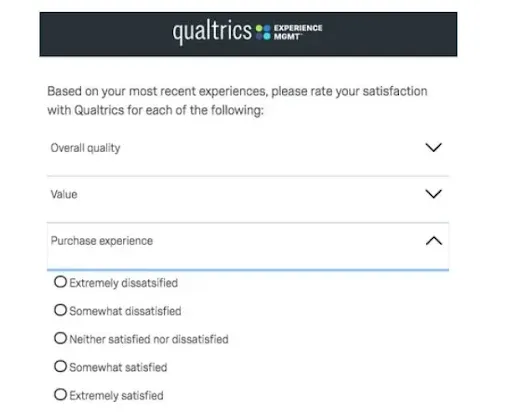
A report on global consumer trends revealed that 62 percent of customers feel that brands should understand their customers better. Surveys are the best way to understand your customers.
2. Segment the audience
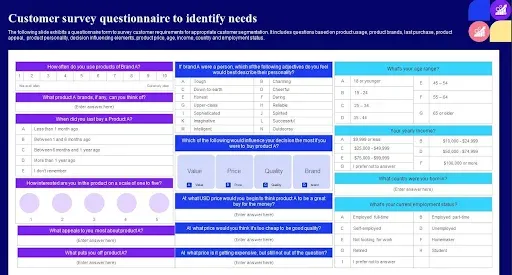
One reason for poor response to your surveys may be due to approaching the wrong people. Your target audience should be very specific to elicit the desired response. Below is a survey example based on market segmentation.
Customer segmentation may be based on demographics, behavior, stage in the buying cycle, etc. Grouping of similar types of customers helps send surveys that attract the specific group. For example, people in the same income groups may have similar buying decisions, and a survey directed at them will fetch the desired results.
3. Plan your timing
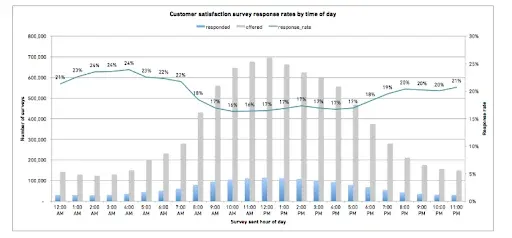
One of the important tips to improve your response rate is the timing. You should pick a time that is most suitable to the audience. Sometimes it can be a particular time of the day. Below is a graph that indicate the time of the day when response rates were high and low.
The response rates dropped during working hours. This indicates that survey emails might have been missed due to more attention toward work at these times.
Apart from this, timing of survey can also be related to time of purchase. Immediately after a purchase, it is easy to extract a response from the customer. The following survey about a car purchase gives out critical information like quality of service, time taken for delivery, etc. The survey results give feedback to the business on areas to improve.
4. Change the tone/design of the survey
If your survey design or tone of addressing the customer is not appealing, you may not get a good response. Making it too formal may not be engaging. You can make the words simpler to attract more attention.
And for the design, open questions take more time to answer, which may not be preferred by your audience. Closed questions based surveys are quick to complete, and the customer is also interested in such types of surveys. So, if your response rates are poor, try modifying the design to suit the audience.
Netflix, for example, which is already a leader in streaming platforms, uses a simple design for surveys. This can easily bring out the necessary response from the audience without being a stress on them.
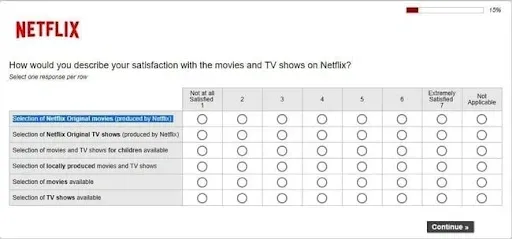
Viewers have to just check the boxes relevant to them, but this gives a huge insight into their preferences, with which Netflix is able to analyze popularity of shows.
5. Use a captivating subject line
An attractive subject line for a survey email is one of the ways to improve your response rates. It instantly grabs the attention of the viewers and compels them to attempt the survey. To be captivating, it need not be complex. Simple words that engage the audience helps.
For example, the below survey starts with a question and is followed by a clear call to action. Attempting the survey is easy as the viewer has to just click on the relevant box. This also includes an element of personalization, since the number of days post purchase is mentioned. This indicates that the brand is concerned about the efficacy of the product for every customer and are ready to accept feedback.
Participation in such a survey will naturally be encouraging and increase the response rates.
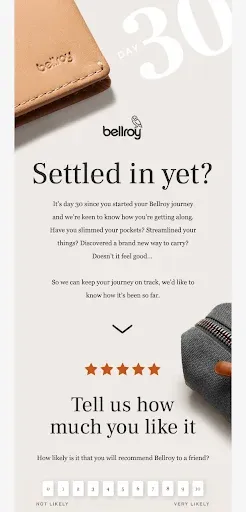
Below is another survey where the attraction is the offer of an incentive. The customers are instantly hooked to the survey and are ready to complete it in full for the incentive. So the survey benefits the consumer as well as the business.
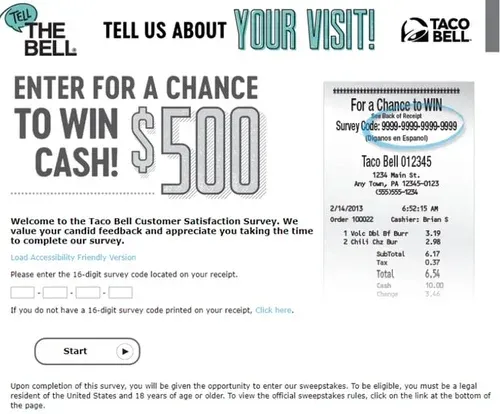
Conclusion
As every business aims for growth, it is imperative to recognize your customers' needs. This is because they play a key role in a business’s growth. Surveys are a proven way to collect feedback from the customers. This important medium has to be used effectively to secure responses from most of your customers.
With the help of responses, you can improve your services and take necessary actions to accelerate your revenues. Use the abovementioned strategies to create better surveys and engage more with your audience.
NFX Digital, a data and digital marketing company in India, focuses on deriving consumer insights by combining digital innovation with human psychology. Their primary tool, Adytude, boasts 9,00,000 reviews from 1,10,000 users across 40 Indian cities.
Challenge: Initially, NFX Digital managed the distribution of respondent rewards, like custom t-shirts and mugs, manually. However, as the respondent base expanded, this manual method became time-consuming and inefficient. They needed an automated, error-free system since rewards were crucial for motivating survey participation.
Solution with Xoxoday: NFX Digital began their relationship with Xoxoday on smaller projects before fully integrating the rewards system. They chose Xoxoday due to:
1. A diverse range of rewarding options, including experiences and gift vouchers.
2. Exceptional customer service, adept at issue resolution.
3. Xoxoday's comprehensive capacity to manage rewards, deliveries, and queries.
With Xoxoday, NFX Digital improved its rewards process, focusing more on their core functions and leaving reward logistics to Xoxoday's instant delivery mechanisms. Furthermore, Xoxoday's excellent customer service resolved issues efficiently. As a result, respondent rewarding grew at a 65% CAGR annually, indicating a growing productive respondent base crucial for NFX's business.
Ayesha Chowdhury from NFX Digital praised Xoxoday's exceptional customer service and highlighted the rarity of issues, which, if occurred, were resolved quickly. She said: “The customer service at Xoxoday is exceptional. Our account managers have been extremely prudent in clarifying queries. The occurrence of an issue is almost never - and even a few odd ones were handled very quickly.”
Solution with Xoxoday: NFX Digital began their relationship with Xoxoday on smaller projects before fully integrating the rewards system. They chose Xoxoday due to:
- A diverse range of rewarding options, including experiences and gift vouchers.
- Exceptional customer service, adept at issue resolution.
- Xoxoday's comprehensive capacity to manage rewards, deliveries, and queries.
With Xoxoday, NFX Digital improved its rewards process, focusing more on their core functions and leaving reward logistics to Xoxoday's instant delivery mechanisms. Furthermore, Xoxoday's excellent customer service resolved issues efficiently.
As a result, respondent rewarding grew at a 65% CAGR annually, indicating a growing productive respondent base crucial for NFX's business. Ayesha Chowdhury from NFX Digital praised Xoxoday's exceptional customer service and highlighted the rarity of issues, which, if occurred, were resolved quickly. She said: “The customer service at Xoxoday is exceptional. Our account managers have been extremely prudent in clarifying queries. The occurrence of an issue is almost never - and even a few odd ones were handled very quickly.”
FAQs on survey response rate
Here are some frequently asked questions about the survey response rate.
What is a good survey response rate?
A good survey response rate typically falls between 50% to 70% for internal surveys (like employee engagement surveys) and around 10% to 30% for external surveys (like customer feedback or market research). However, these rates can vary based on the survey type, audience, and distribution method.
What is the minimum acceptable survey response rate?
The minimum acceptable survey response rate often depends on the survey's objective and target audience. For statistical significance in many general population surveys, a rate of at least 5-10% might be acceptable. However, for more targeted studies, a higher rate, often 20-30%, may be desired to ensure the sample's representativeness.
What are the common reasons for low survey response rates?
The common reasons for low survey response rates are:
- Lengthy and complex surveys
- Lack of participant engagement
- Poor survey design
- Survey fatigue
- Lack of perceived benefits or incentives
What are some best practices for survey design to improve response rates?
- Keep it short: Minimize survey length to prevent respondent fatigue.
- Clear language: Use simple, clear language to ensure understanding.
- Logical flow: Organize questions logically to maintain participant engagement.
- Randomize answers: Randomize answer choices to avoid order bias.
- Progress indicator: Include a progress bar to show respondents' completion status.
- Pre-test: Test with a small group to identify and fix issues.
- Personalize invitations: Address participants by name and explain survey importance.
- Clear instructions: Provide clear guidance on survey completion.
- Question variety: Mix question types for diversity and participant interest.
- Mobile optimization: Ensure the survey is mobile-friendly for wider accessibility.
- Confidentiality assurance: Communicate confidentiality and anonymity of responses.
- Offer incentives: Provide rewards or discounts to motivate participation.
- A/B testing: Experiment with survey variations to optimize design.
- Polite reminders: Send non-intrusive reminders to non-respondents.
Do incentives increase survey response rates?
Yes, incentives, whether monetary or non-monetary, often increase survey response rates by providing motivation for participants to complete the survey.
How to increase survey response rate?
To increase the survey response rate:
- Ensure your survey is concise and relevant.
- Use clear and engaging language.
- Optimize the survey for mobile devices.
- Personalize your survey invitation.
- Provide incentives for completion.
- Send reminder emails or notifications.
- Choose the optimal time and day for distribution.
How to deal with a low response rate in a survey?
If faced with a low response rate:
- Re-evaluate the survey's length and complexity.
- Adjust the survey's distribution method or platform.
- Consider adding or enhancing incentives.
- Improve the clarity and relevance of questions.
- Send follow-up reminders to potential respondents.
- Consider re-segmenting or re-targeting your audience.
- Finally, if the rate remains low, acknowledge the limitation when analyzing or presenting results.


